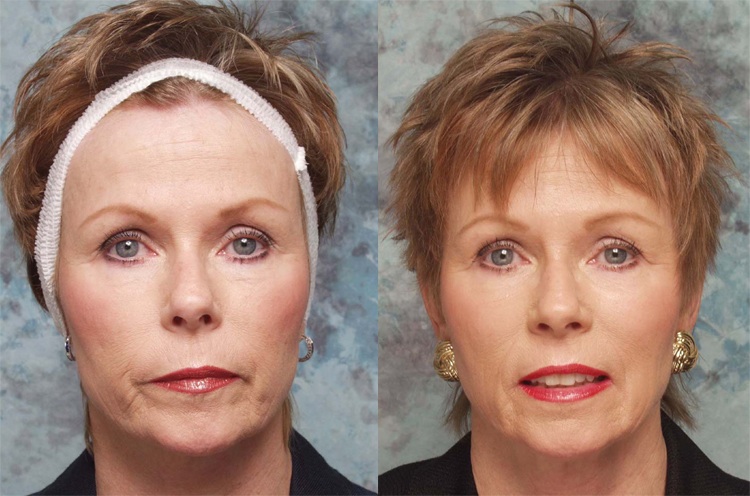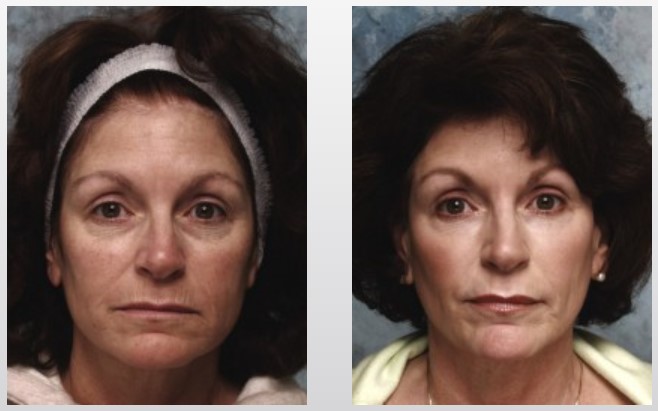Common chemical peel agents include:
- Alpha Hydroxy Acids (AHA): derived from fruit and dairy products, this category of agents is commonly utilized for skin smoothing, correction of pigmentation/discoloration issues, acne treatment, and to stimulate the production of collagen and elastin (proteins responsible for maintaining youthfully firm, supple skin). Glycolic acid is the most commonly used agent in this category and can be incorporated in a variety of concentrations—lower concentration glycolic acid products (2-15%) are available as over-the -counter skin rejuvenation products, while higher strengths (8-30%) are distributed to estheticians for freshening facials, and the most powerful formulations (40-70%) are available to cosmetic surgeons for use in chemical peel treatments. The strength of a glycolic acid peel is dependent upon its concentration, pH, and the length of time the acid acts on the skin before it is neutralized.
- Jessner’s Solution: this combination of resorcinol, salicylic acid, and lactic acid serves as a mild peeling agent. Jessner’s solution can be combined with Trichloroacetic acid (TCA) 35% to enhance the penetration of the TCA into the papillary dermis, thereby facilitating a peel of moderate depth with a good safety margin.
- Trichloroacetic Acid (TCA): can be used in a variety of strengths depending on the desired effect. A 10% TCA peel is appropriate for patients seeking a mild, freshening peel. After a 10% TCA peel, patients may experience a mild burn and temporary redness, but will be able to achieve revitalized, smoother skin (this effect can be amplified with up to 20% concentration). At concentrations of 25-35%, the TCA peel becomes sufficiently uncomfortable that patients benefit from regional anesthesia and oral or intravenous sedation.
Immediately after the peel, patients experience a frosting of the skin. This is caused by the immediate effect of the peel agent on the superficial skin proteins. The first 24 hours after a 35% TCA peel, patients will experience first redness and then darkening of the peeled skin. Over the next 5-7 days, the skin will begin to shed to reveal a fresh, pink epithelium, which may take several days before it is completely healed and intact.
Post-operative skin care can be managed with gentle wound debridement and bland petrolatum dressing until the epithelium is fully formed. There is little tendency for hypopigmentation (skin lightening) after TCA peels; however, trichloroacetic acid solutions should not be used in concentrations above 50%, as these levels are unpredictable and can result in unexpected scarring.
- Phenol and Baker’s Formula: these powerful, highly-effective agents are able to significantly improve sun damage, sun-spots, actinic keratosis and frank in-situ squamous cell carcinomas. Phenol 89% solution is considered a medium deep peeling agent, and is capable of improving the appearance of all but the deepest lines/wrinkles. Phenol causes tissue injury to the epithelium with varying degrees of edema and inflammation in the reticular dermis. This triggers the body’s natural regeneration of the epithelium, resulting in dermal thickening, new collagen, and elastin deposition. Baker’s solution penetrates deep to the reticular dermis to treat damaged skin at its source.
When used properly, both phenol and Baker’s formula are capable of producing an overall tightening effect that can, in select patients, rival the results of a surgical face lift. Although full-face phenol applications are associated with cardiac arrhythmia, most patients do not need full-face phenol applications. By limiting the application of phenol to small, targeted areas of the face that need the greatest help, cardiac irritation is avoided. Patients who have had a phenol peel can take up to 10 to 12 days to heal. During this period, the skin is gently debrided with frequent showers and dressed with a bland petrolatum. The skin can stay red up to 4-6 months after this type of peel, often necessitating cover-up with makeup. Men often find that this slight redness blends easily into their complexion and does not raise questions about what they have had done.
The relative strength of the aforementioned chemical agents necessitates caution in their application, as overzealous application can lead to facial scarring. Dr. Steinsapir believes in taking a conservative approach to avoid this type of problem, which makes it possible to have a powerful, full-face peel that produces excellent results under local anesthesia with only a low dose of pain medication.


